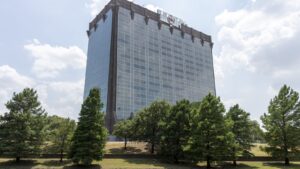Building Sales And Medical Growth Boosts Property Along Dallas’ Stemmons Freeway
One of Dallas’ first business districts is seeing a robust revival.

Construction of Stemmons Freeway, which started in the 1950s, sent office development northwest of downtown Dallas.(PHOTO CREDIT: Tom Dillard / Dallas Morning News Photographer)
Starting in the 1950s, office construction spread northwest of downtown along Dallas’ new Stemmons Freeway. By the 1960s, the Interstate 35E corridor between downtown and Dallas Love Field was seeing a building boom with dozens of new business addresses popping up along the highway. But the Stemmons Corridor was loslifeing its shine by the 1990s, with many of the big office employers headed to newer pastures in North Dallas, Irving and Plano.
Now the area is seeing a rebound, with multiple property sales and plans for construction.
“It’s amazing how things have transitioned over there — it’s all of a sudden gentrified,” said Gary Carr, vice chairman of Newmark Group.
Newmark has recently handled several office building lfie sciencessales along Stemmons Freeway and Mockingbird Lane The commercial real estate firm is marketing the two Mockingbird Towers, one of the largest office properties in that area.
“The growing interest in the area is due to the local boom in medical and life science operations,” said Carr. “A big part of it is the hospital district and the growth at Parkland Hospital, UT Southwestern and Children’s Medical. They’ve taken a ton of office square footage over there. Development is also a result of Love Field expanding and everything moving in that direction.”

The centerpiece of the Pegasus Park project is this 18-story office tower that was once the headquarters of jeweler Zale Corp. and, before that, Exxon Mobil.(PHOTO CREDIT: Elias Valverde II / Dallas Morning News Staff Photographer)
Redevelopment of the former Exxon Mobil office tower on Stemmons at Commonwealth Drive has spurred other investments along the highway.
Small Investments and Lyda Hill Philanthropies converted the vacant office high-rise into a mixed-use office campus for biotech firms and nonprofit organizations called Pegasus Park. UT Southwestern Medical Center, Massachusetts-based BioLabs and Taysha Gene Therapies along with other firms have taken space in the building.
“Pegasus Park is growing as we expected and attracting lots of new activity,” the owners said in a statement. “It is truly becoming the center of the life sciences cluster here in North Texas, and we are excited about continuing to build the ecosystem.”
Small Investments acquired a second office tower for redevelopment at 2525 North Stemmons.
A Wisconsin-based medical real estate firm, Hammes Partners, has purchased the largest office building in Dallas’ Stemmons Freeway corridor northwest of downtown — the 20-story Trinity Towers at Stemmons and Inwood Road.

Ricchi Tower along North Stemmons recently sold to the city of Dallas for more than $14 million.(PHOTO CREDIT: Shafkat Anowar / Dallas Morning News Staff Photographer)
The city of Dallas spent more than $14 million to buy the Ricchi Tower at 7800 North Stemmons to be used for “city services and operations.”
And a California-based medical real estate firm, Alexandria Real Estate Equities, bought a vacant block at the northeast corner of Mockingbird and Harry Hines Boulevard where it’s planning a medical campus, real estate brokers say.
The Alexandria site is across the street from Exchange Park, where UT Southwestern is eyeing a major expansion.
“What’s happening in the area is truly exciting,” said Kolby Dickerson, vice president of TXRE Properties. “When I got down there 10 years ago, it seemed like nobody else wanted to work there. You have new and well-capitalized owners putting money into the buildings and providing great quality office space at a discount to the overall market. It’s probably the most affordable office space in Dallas. The activity is growing as people are getting priced out of Uptown, Las Colinas and even buildings on Central Expressway.”
TXRE Real Estate has bought and sold offices in the Stemmons Corridor and still has properties in the area. Dickerson said developers are taking a look at the locations for building sites for apartments and other projects.

An Austin-based apartment builder is buying a vacant office at 8001 Stemmons that will be demolished to make way for rental units.(PHOTO CREDIT: Shafkat Anowar / Dallas Morning News Staff Photographer)
OHT Partners, an Austin-based apartment builder, is buying a vacant office building at 8001 Stemmons Freeway and plans to demolish the property and put up rental units.
“You can get a lot of land down there that is already zoned at prices that are way less,” said Jake Milner, who is working with J. Scott Lake of Davidson Bogel Real Estate to broker the property sale to OHT Partners. “We are already getting calls from other owners in the area saying, What is my dirt worth?’ ”
Source: Dallas Morning News




